Picture this: you’ve had a long, stressful day, and all you want is to sink into your hot tub for some well-deserved relaxation.
But as you lift the cover, you’re greeted by a frothy, bubbly mess that looks more like a giant bubble bath than a soothing spa.
Ugh, talk about a mood killer! I’ve been there, and let me tell you, it’s not fun. But don’t worry, I’ve got your back.
Let’s dive into the foamy world of hot tubs and figure out what’s causing this bubbly nightmare and whether it’s something you should be concerned about.
Why is My Hot Tub Foamy and Is Hot Tub Foam Dangerous?
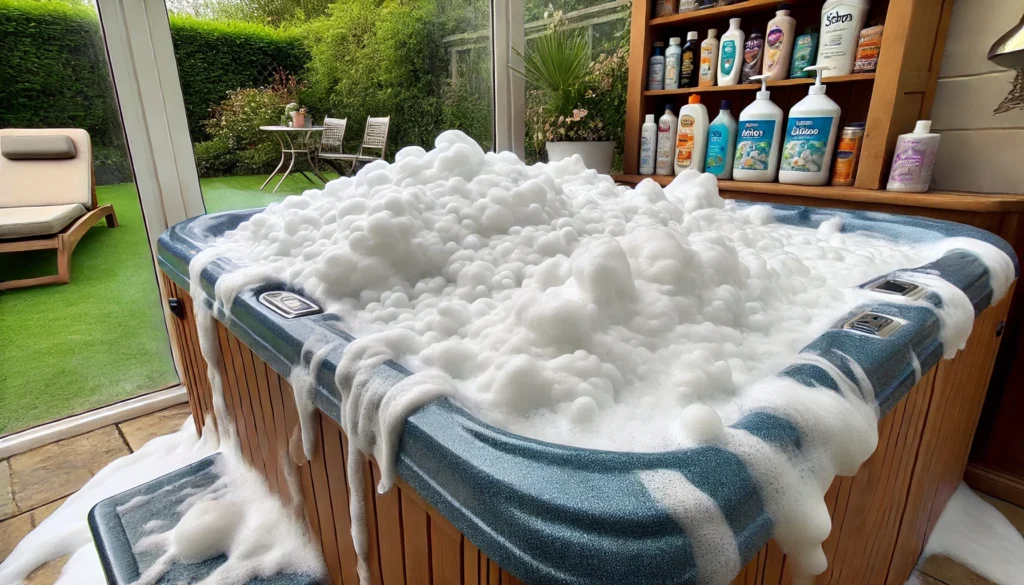
Hot tub foam is typically caused by a buildup of organic compounds, such as body oils, lotions, and soap residue, combined with imbalanced water chemistry.
While not immediately dangerous, excessive foam can indicate poor water quality and potentially harbor bacteria.
It’s best to address the issue promptly to ensure a safe and enjoyable hot tub experience.
Don’t worry, though – we’ll explore this topic more deeply below and get your hot tub back to its bubble-free glory!
What Causes Hot Tub Foam?
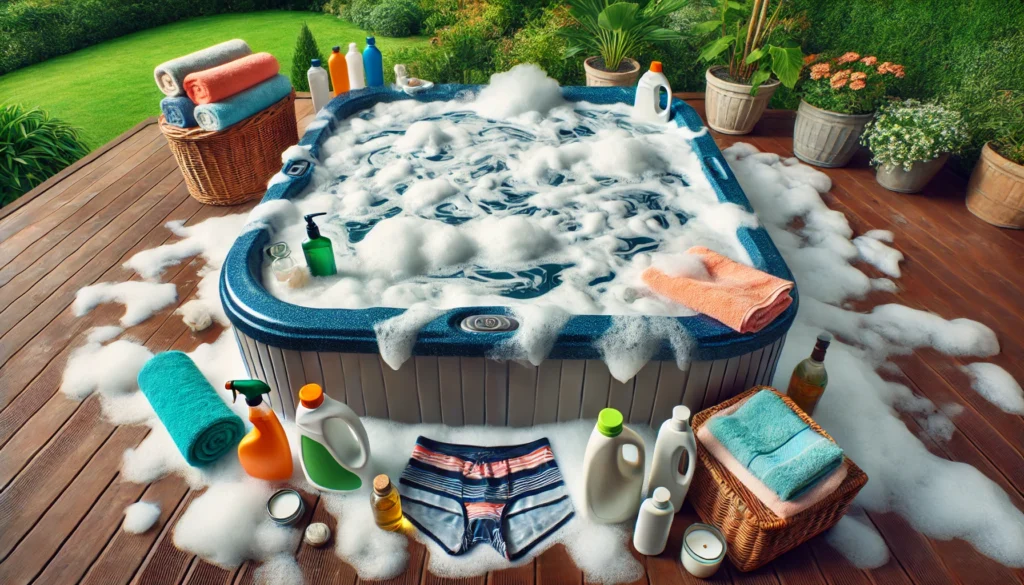
Alright, let’s get to the bottom of this bubbly mystery. Trust me, I’ve dealt with my fair share of foamy hot tubs, and it’s always been a frustrating experience.
But over the years, I’ve learned a thing or two about what causes this frothy fiasco.
First things first, the main culprit behind hot tub foam is usually a buildup of what we call Total Dissolved Solids (TDS). Sounds fancy, right? Well, it’s just a fancy way of saying “stuff that’s dissolved in your water.”
This “stuff” can come from a variety of sources, and I bet you’re guilty of contributing to at least a few of them!
One time, I threw a hot tub party, and the next day, my spa looked like a bubble bath on steroids. Turns out, all those people brought in a ton of lotions, oils, and other gunk that got left behind in the water.
Lesson learned: always ask your guests to shower before hopping in!
But it’s not just what we bring into the tub. Sometimes, the problem starts before we even get in. Detergent residue from swimsuits can be a major foam-producer.
I once made the mistake of wearing a new pair of swim trunks without rinsing them first – big mistake! The hot tub looked like a laundromat gone wrong.
Now, here’s where it gets a bit technical (but don’t worry, I’ll keep it simple). Your hot tub’s water chemistry plays a huge role in foam production. If your pH levels are out of whack or your alkalinity is off, it can create the perfect environment for foam to form.
It’s like creating a little bubble factory in your spa!
And let’s not forget about those pesky organic compounds. Dead skin cells, sweat, and even certain foods and drinks can contribute to the foam problem. I once spilled a bit of beer in my hot tub (don’t judge, accidents happen!), and boy, did that create some impressive suds.
The tricky thing about foam is that it can be a vicious cycle. The more contaminants in your water, the more likely you are to get foam.
And the more foam you have, the harder it is for your filtration system to work effectively, which means more contaminants stick around. It’s like a never-ending foam party, and not the fun kind!
But don’t lose hope! Understanding what causes hot tub foam is the first step in preventing it. And trust me, once you get the hang of it, maintaining a foam-free hot tub becomes second nature.
Just remember, every time you slip into that warm, bubbly water, you’re bringing a little bit of the outside world with you. So be mindful, and your hot tub will thank you!
Is Hot Tub Foam Dangerous?
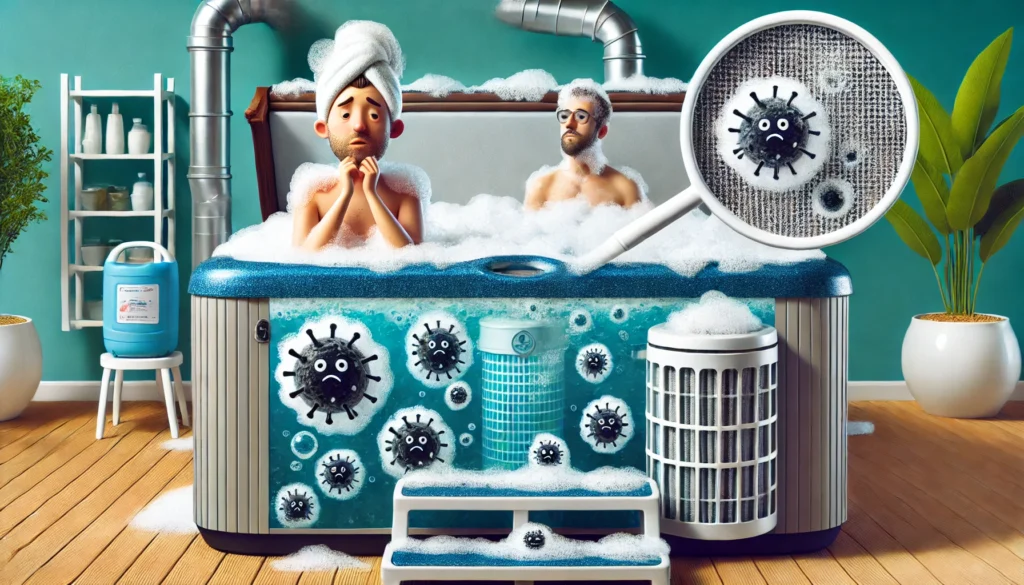
Now, I know what you’re thinking: “Is this foamy mess actually dangerous, or is it just annoying?” Well, my friend, the answer isn’t as straightforward as we’d like it to be. Let me break it down for you based on my years of experience (and a few foam-related mishaps).
First off, let’s address the elephant in the room – or should I say, the bubbles in the tub. While a little bit of foam isn’t going to turn your relaxing soak into a health hazard overnight, it’s definitely not something you want to ignore.
Think of it as a warning sign, like that weird noise your car makes before something goes seriously wrong.
Here’s the deal: foam itself isn’t inherently dangerous. It’s not like it’s going to reach out and grab you or anything (though wouldn’t that make for a great horror movie?). The real danger lies in what the foam represents and what it might be harboring.
You see, all that foam is basically a sign that your hot tub water is out of balance and potentially contaminated. It’s like a big, bubbly billboard saying, “Hey! There’s too much gunk in here!”
And where there’s gunk, there might be bacteria. Ew, right?
I learned this the hard way once. I ignored a foamy hot tub for way too long, thinking it was no big deal. Big mistake!
I ended up with a nasty skin rash that took weeks to clear up. Trust me, itchy, red skin is not the souvenir you want from your hot tub experience.
But it’s not just about skin irritation. If the water quality is poor enough to create foam, it might also be harboring some nasty microorganisms. We’re talking about potential pathogens that could cause infections or other health issues.
Now, I’m not trying to scare you – the risk is generally low if you’re maintaining your hot tub properly. But it’s definitely something to be aware of.
And let’s not forget about respiratory issues. If you’re soaking in a super foamy hot tub, you might be inhaling some of those contaminated water particles. I once had a coughing fit after spending time in a particularly frothy spa.
Not fun, and definitely not the relaxing experience I was going for!
Now, here’s something that often gets overlooked – the impact on your hot tub itself. All that foam can actually damage your spa equipment over time. It can clog up your filters, mess with your pumps, and even corrode some of the surfaces.
I learned this lesson when I had to replace my hot tub’s pump way earlier than expected. Turns out, foam is not just a cosmetic issue!
So, is hot tub foam dangerous? Well, it’s not going to turn into a monster and eat you (again, great movie idea, right?). But it’s definitely a sign that something’s not right, and ignoring it could lead to some unpleasant consequences for both you and your spa.
The bottom line is this: a little foam now and then isn’t the end of the world. But if you’re seeing persistent foaming, it’s time to take action.
Your health, your comfort, and your hot tub will thank you for it. And hey, isn’t a crystal-clear, foam-free hot tub so much more inviting anyway?
How to Prevent Hot Tub Foam
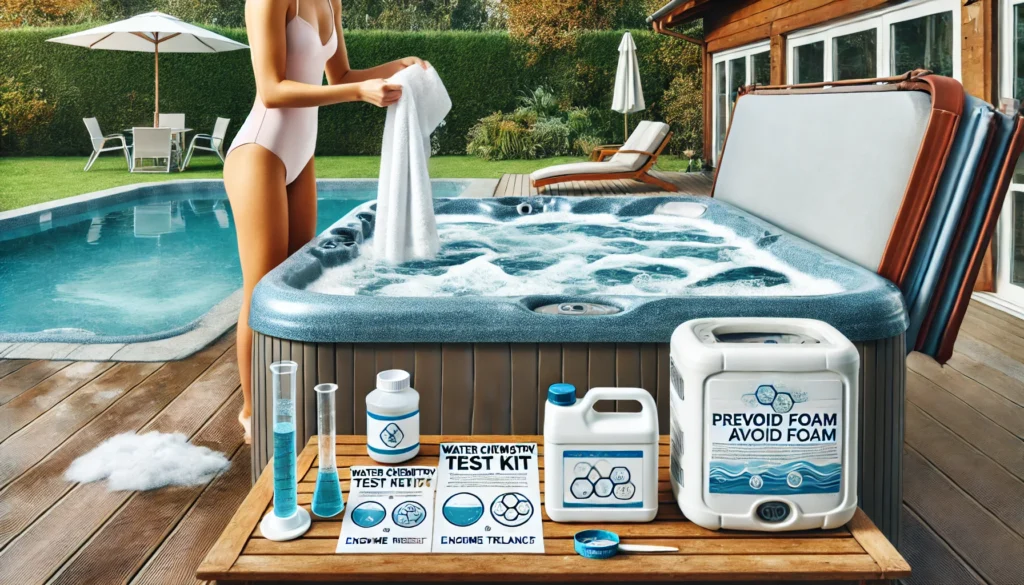
Alright, now that we’ve covered the “why” and “is it dangerous” parts, let’s get down to the nitty-gritty: preventing that pesky foam from showing up in the first place. Trust me, after dealing with my fair share of frothy fiascos, I’ve picked up some tricks that’ll keep your hot tub as smooth as a freshly waxed surfboard.
First things first, let’s talk about the golden rule of hot tubbing: shower before you soak! I know, I know, it seems counterintuitive to shower before getting into water, but trust me on this one.
One time, I skipped my pre-soak shower after a sweaty workout, and my hot tub looked like a bubble bath gone wild the next day. Lesson learned! A quick rinse will wash away all those oils, lotions, and other gunk that contribute to foam formation.
Next up, let’s chat about your hot tub’s diet. Yep, you heard me right – what you feed your hot tub matters!
I’m talking about the chemicals you use to keep it balanced. Maintaining proper water chemistry is crucial in preventing foam. Test your water regularly (I do it at least once a week) and keep those pH and alkalinity levels in check.
It’s like feeding your hot tub a balanced diet – keep it happy, and it’ll return the favor!
Now, here’s a tip that took me way too long to figure out: rinse your swimwear! Detergent residue on swimsuits is like foam fuel. I once wore a freshly washed swimsuit without rinsing it first, and let me tell you, my hot tub looked like a laundromat explosion.
Now, I always give my suits a quick rinse before taking a dip.
Let’s talk filters. Your hot tub’s filter is like its kidney – it helps remove all the nasty stuff from the water. But just like our kidneys, it needs some TLC to function properly.
Clean your filters regularly (I do it monthly), and don’t forget to deep clean or replace them as needed. A clogged filter is about as useful as a screen door on a submarine when it comes to preventing foam.
Here’s a pro tip I picked up after years of hot tub ownership: use enzyme treatments. These little miracle workers break down organic contaminants that can cause foam. I add them to my hot tub weekly, and it’s made a world of difference.
It’s like giving your hot tub a little digestive aid to help it process all the gunk.
Now, let’s address the elephant in the room – or should I say, the people in the tub. Be mindful of what you’re bringing into the water. I once made the mistake of letting my friends use the hot tub right after they applied sunscreen.
Big mistake! The oils from the sunscreen turned my hot tub into a foamy mess. Now, I always ask guests to shower off any lotions or oils before hopping in.
Lastly, don’t forget about regular water changes. Even with the best maintenance, water can get “tired” over time. I completely drain and refill my hot tub every 3-4 months.
It’s like giving your spa a fresh start, and trust me, it makes a huge difference in preventing foam.
Remember, preventing foam is all about being proactive. It might seem like a lot of work at first, but trust me, it becomes second nature after a while. And the payoff?
A crystal-clear, foam-free hot tub that’s always ready for a relaxing soak. Take it from someone who’s battled the foam demons and won – a little prevention goes a long way in hot tub happiness!
How to Get Rid of Hot Tub Foam
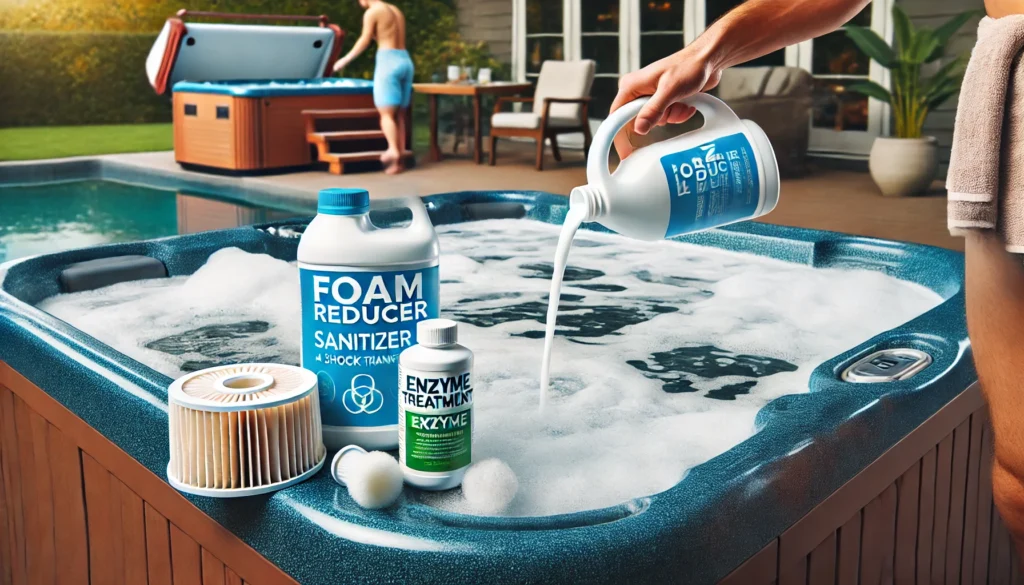
Okay, so you’ve followed all the prevention tips, but you’re still facing a foamy situation. Don’t worry, I’ve been there, and I’ve got some tricks up my sleeve to help you banish that foam for good!
First things first, let’s tackle the immediate problem. You want to enjoy your hot tub now, not wait for some long-term solution to kick in, right?
Well, here’s a quick fix that’s saved my bacon more than once: foam reducers. These magical little products are like kryptonite for hot tub foam. Just add a capful or two (follow the instructions on the bottle), and watch that foam disappear faster than free food at an office party.
But here’s the thing – foam reducers are like putting a band-aid on a leaky pipe. They’ll stop the foam for now, but they won’t fix the underlying issue.
So while you’re enjoying your foam-free soak, let’s talk about some long-term solutions.
First up, shock your hot tub. No, I don’t mean scare it – I’m talking about adding a sanitizing shock treatment. This will help break down all those organic contaminants that are causing the foam in the first place.
I learned this trick after a particularly rowdy hot tub party left my spa looking like a bubble bath. A good shock treatment had it back to normal in no time.
Next, let’s talk about your water. If you’ve been fighting foam for a while, it might be time for a fresh start. Drain that tub, give it a good clean (don’t forget those jets and crevices!), and refill it with fresh water.
It’s like giving your hot tub a clean slate. I do this every few months as part of my regular maintenance, and it works wonders for preventing foam.
Now, here’s a trick that took me years to discover: enzyme treatments. These little miracle workers break down oils and organic matter that can cause foam. Add them to your regular maintenance routine, and you’ll see a big difference.
I use them weekly, and my hot tub has never been happier.
Don’t forget about your filters! Dirty filters can’t do their job properly, which means more gunk in your water and more foam. Give those filters a deep clean, or if they’re old, consider replacing them.
Trust me, your hot tub will thank you.
Here’s a tip that might surprise you: check your water source. If you’re using soft water to fill your hot tub, you might be inadvertently contributing to the foam problem. Soft water can sometimes cause excessive foaming.
I learned this the hard way after moving to an area with soft water. The solution? Use a hose filter when filling your tub, or consider adding a bit of calcium to harden the water slightly.
Lastly, and I can’t stress this enough, get your water chemistry right! Imbalanced pH and alkalinity levels can contribute to foaming. Invest in a good test kit and check your water regularly.
It might take some trial and error (trust me, I’ve been there), but once you find the right balance, your foam problems will be a thing of the past.
Remember, getting rid of hot tub foam is part science, part art. It might take some experimentation to find what works best for your specific situation. But don’t get discouraged!
With a little patience and persistence, you’ll be enjoying a foam-free hot tub in no time.
One last piece of advice from someone who’s been in the trenches of foam warfare: keep a log of what you do and how your hot tub responds. I started doing this after trying everything under the sun to combat foam, and it really helped me pinpoint what worked best for my specific situation.
Plus, it’s oddly satisfying to see your progress over time!
When to Seek Professional Help
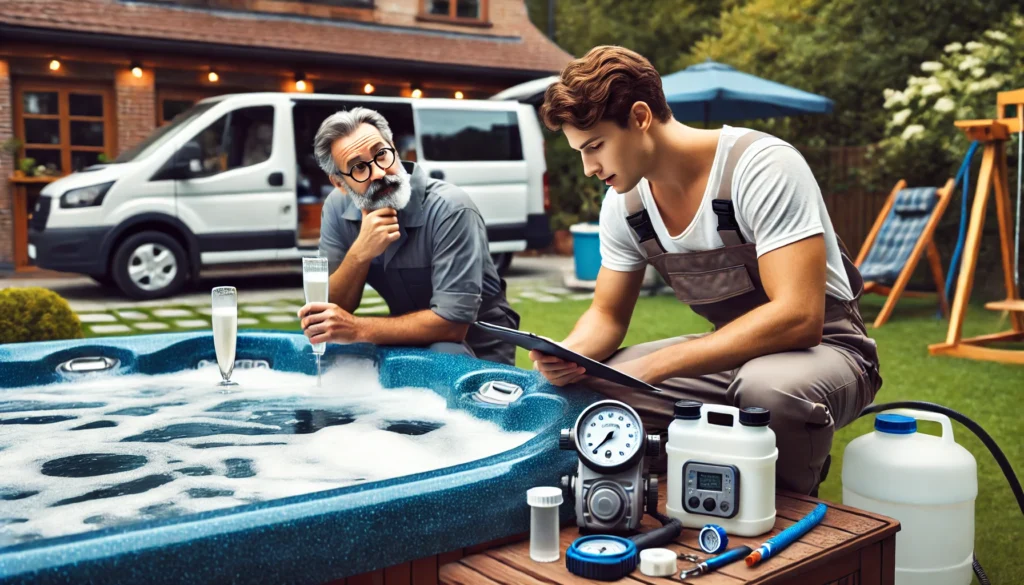
Alright, I’ll be the first to admit it – sometimes, even with all our best efforts, we need to call in the big guns. There’s no shame in seeking professional help when it comes to hot tub maintenance.
In fact, it can save you a lot of headaches (and money) in the long run.
So, when should you wave the white flag and call a pro? Well, let me tell you about the time I thought I could handle a persistent foam problem on my own. I tried every trick in the book – shocking, draining, refilling, you name it.
But that darn foam just kept coming back. It was like playing whack-a-mole with bubbles! After weeks of frustration (and way too much money spent on chemicals), I finally swallowed my pride and called a professional.
Turns out, I had a small leak that was throwing off my water chemistry. Who knew?
Here are some signs that it might be time to bring in an expert:
- Persistent foam that doesn’t respond to your usual treatments. If you’ve tried all the tips we’ve discussed and you’re still seeing foam, it’s time to call for backup.
- Unusual odors coming from your hot tub. Once, my hot tub started smelling like rotten eggs.
I thought I could fix it myself, but it turned out to be a complex bacterial issue that needed professional treatment.
- Cloudy water that won’t clear up. If your water looks more like milk than crystal-clear relaxation, a pro can help identify the underlying cause.
- Skin irritation or rashes after using the hot tub. This happened to me once, and let me tell you, it’s not fun.
A professional can help ensure your water is safe and balanced.
- Equipment issues like weird noises, malfunctioning jets, or heating problems. I once ignored a strange humming sound, thinking it was no big deal.
Big mistake! It ended up being a pump issue that could have been fixed easily if I’d called a pro earlier.
Now, I know what you’re thinking – “But won’t professional help be expensive?” Well, here’s the thing: in my experience, it’s often more cost-effective to get expert help sooner rather than later. Those small issues can turn into big, expensive problems if left unchecked.
Plus, professional hot tub technicians have seen it all. They can often spot issues that we might miss and provide solutions we hadn’t even thought of. It’s like having a hot tub guru on speed dial!
One time, I called in a pro for a persistent foam issue, and not only did they solve the problem, but they also gave me some great tips for ongoing maintenance. It was like getting a mini-course in hot tub care!
So, don’t be afraid to reach out for professional help when you need it. Your hot tub (and your stress levels) will thank you for it.
Conclusion
Whew! We’ve been on quite a journey through the world of hot tub foam, haven’t we? From understanding why our beloved spas sometimes turn into bubble baths, to learning about the potential dangers, and finally, mastering the art of foam prevention and elimination.
It’s been a bubbly adventure!
Let’s recap the key points we’ve covered:
- Hot tub foam is usually caused by a build-up of oils, soaps, and other organic compounds, combined with imbalanced water chemistry.
- While not immediately dangerous, excessive foam can indicate poor water quality and potentially harbor bacteria.
- Prevention is key – shower before soaking, maintain proper water chemistry, clean filters regularly, and be mindful of what you bring into the tub.
- If foam does appear, there are several strategies to combat it, from using foam reducers to shocking the tub and performing a deep clean.
- When in doubt or facing persistent issues, don’t hesitate to call in a professional.
Now, here’s the thing – every hot tub is unique, just like its owner. What works for my hot tub might need a little tweaking for yours.
So don’t be afraid to experiment (safely, of course) and find what works best for your specific situation.
Remember, maintaining a foam-free hot tub isn’t just about having a pretty spa to look at (although that’s definitely a perk). It’s about ensuring a safe, healthy, and enjoyable experience every time you take a dip.
Trust me, there’s nothing quite like sinking into crystal-clear, foam-free water after a long day. It’s pure bliss!
So, the next time you lift your hot tub cover and see nothing but clear, inviting water, give yourself a pat on the back. You’ve mastered the art of foam control, my friend!
And hey, why not share your hot tub maintenance tips and tricks with others? I’d love to hear about your experiences in the comments below. What’s your go-to method for keeping foam at bay?
Any funny foam-related stories to share? Let’s keep the conversation bubbling!
Stay foam-free, my friends, and happy soaking!



